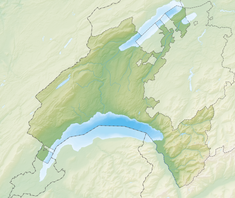Reformed Church of Saint-Symphorien
| Reformed Church of Saint-Symphorien | |
|---|---|
| Native name French: Église réformée Saint-Symphorien | |
 The church seen from the village | |
| Type | Parish church of the Evangelical Reformed Church of the Canton of Vaud |
| Location | Saint-Saphorin, canton of Vaud, Switzerland |
| Coordinates | 46°28′24″N 06°47′48″E / 46.47333°N 6.79667°ECoordinates: 46°28′24″N 06°47′48″E / 46.47333°N 6.79667°E |
| Built | around 590 |
| Official name | Église réformée Saint-Symphorien avec villa gallo-romaine et cure |
| Criteria | Class A |
| Reference no. | 6489 |
 Location of Reformed Church of Saint-Symphorien in Switzerland | |
The Reformed Church of Saint-Symphorien (French: église réformée Saint-Symphorien) is a Protestant church in Saint-Saphorin, canton of Vaud, Switzerland. It is listed as a heritage site of national significance.
History[]
The first Catholic church in the region of Lavaux was established by Marius of Avenches around 590 and was dedicated to Symphorian of Autun, as was the church of Avenches.[1] Later, the church gave its name to the village which was previously called Glérolles (Glerula in Latin).[2]
Between the 12th century and the 1536 conquest by the canton of Bern, the village and the church belonged to the Bishops of Lausanne whose last titular, , is shown kneeling in front of the Virgin Mary on the main stained glass of the church.[3] After 1536 and the introduction of the Reformation, the church was used by the Protestants. At this time, Saint-Saphorin was the seat of a parish that included the villages of Rivaz, Chexbres and Puidoux until 1734 when Chexbres and Puidoux formed an independent parish. In 2000, the older parish was re-united under its former name, Saint-Saphorin.[4]
The church of Saint-Symphorien was listed among the Cultural Property of National Significance (Class A),[5] as were the remains of the Gallo-Roman villa[5] located on the site until a tidal wave caused Mount Tauredunum to collapse in 563.[6]
See also[]
References[]
| Wikimedia Commons has media related to Église réformée Saint-Symphorien. |
- ^ Meylan, Henri (1973). Pays de Vaud Une Terre Une Histoire (in French). Éditions Cabédita. p. 28. ISBN 9782882951779.
- ^ "Saint-Saphorin". erwan.gil.free.fr (in French). Retrieved November 20, 2012.
- ^ Berger, Ric; Linder, Jean-Gabriel; Christinat, Jacques (1990). Lavaux (in French). Éditions Cabédita. p. 65. ISBN 9782882950376.
- ^ "Histoire de la Paroisse de Saint-Saphorin (Lavaux)". saint-saphorin.ch (in French). Retrieved November 20, 2012.
- ^ Jump up to: a b "Église réformée Saint-Symphorien avec villa gallo-romaine et cure". Swiss Inventory of Cultural Property of National Significance (in French). (FOCP). Retrieved November 11, 2019.
- ^ "La crypte de Saint-Saphorin". bonnenouvelle.ch. Retrieved November 20, 2012.
- Reformed church buildings in Switzerland
- Churches in Vaud
- 6th-century establishments in Europe
- 6th-century churches
- Cultural property of national significance in the canton of Vaud
- European church stubs
- Swiss building and structure stubs


